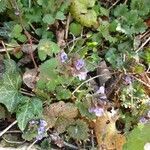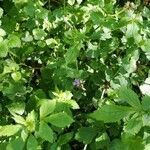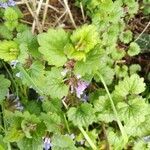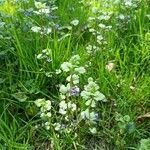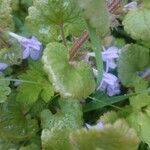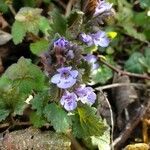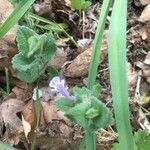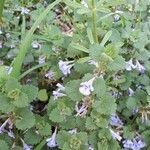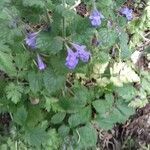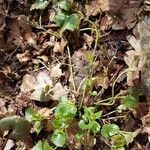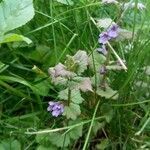Fibrous-rooted perennial from slender stolons or superficial rhizomes, the stems lax, 1–4 dm, retrorsely scabrous (or hirsute) to subglabrous, pilose at the nodes; lvs all about alike, petiolate, the blade glabrous or hirsute, rotund-cordate to cordate-reniform, strongly crenate, 1–3 cm; fls short-pedicellate; cal narrow, 5–6 mm, hirtellous-scabrous, the upper teeth the longer; cor blue-violet, purple-maculate, 13–23 mm, or in pistillate plants only 8–15 mm, the anthers then minute and included in the cor-tube; 2n=18, 36. Moist woods and various disturbed habitats; native of Eurasia, now found throughout our range. Apr.–June. (Nepeta h.)
A herb. It has a creeping ivy-like growth habit. It creeps along the ground. It grows 15 cm high and spreads 2 m wide. The stems are square. They root at the nodes. The leaves are greyish-green. They have a crinkly edge and are hairy. They are heart shaped. The leaves occur in pairs. The flowers are purple blue. There are 5 petals which are fused together. The 2 lower lips are covered with white dots. It has a mint like smell when the leaves are crushed.
Herb; non-flowering stems hairy, creeping and rooting at nodes. Petiole slender. Lamina 1-3.5 × 1-4.5 cm, suborbicular to reniform, sparsely to densely hairy, especially beneath, shallowly to deeply crenate; base cordate. Calyx c. 5 mm long, 15-nerved; nerves hairy; teeth triangular-acuminate. Corolla 1-1.5 cm long, blue or blue-violet, hairy outside; lower lip with purple spots. Nutlets not seen.

